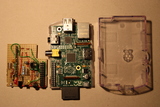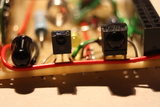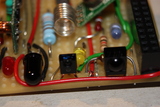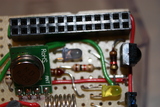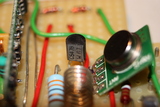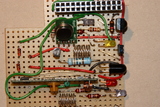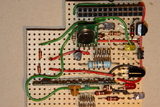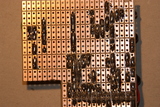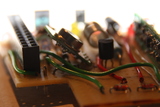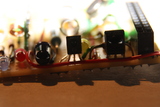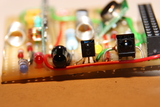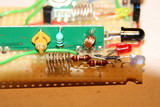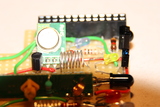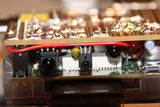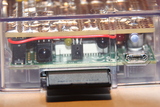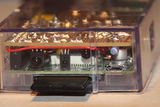Raspberry Pi daughter board for IR and RF transmission and reception
| Date | Description |
|---|---|
| 2014-01-11 | Initial version. |
Description
This article shows a daughter board for fitting to the GPIO Pins of a Raspberry Pi. It is mainly intended for use with LIRC. It necessitated the development of an an improved LIRC driver.
It is built upon a "TriPad" board. It contains of a 2 x 13 board connector and a number of standard components. There is an IR transmitting LED (SFH415) with an NPN driver transistor (BC547) driver transistor. It is designed to be able to withstand 100mA of continuous current through the IR LED. There is also an IR-demodulator TSOP4838. For the LIRC world uncommon is the non-demodulating IR sensor QSE159, which makes it possible to determine the modulation frequency of a captured signal. This works with 5V supply voltage, that could cause a problem for the 3.3V operating GPIO pins. Selecting an open collector model like QSE159 solves this problem however. Unfortunately, at the time of this writing, supporting drivers have not been written yet.
Also contained are an RF 433MHz sender (TX433) and Receiver (RX433). The wire coils are antennas for these. Since the photos were made, an 100nF capacitator has been added between power supply and ground of the RF receiver, to reduce disturbances. From the LIRC drivers, the receiver is addressed exactly like a demodulating IR-receiver, while the transmitter should not be feed with a modulated signal, thus posing another software problem for LIRC. This will be discussed further here.
There are also a number of "Debug-LEDs", one of them being a "dummy-IR", to demonstrate the multi-transmitter facility of the improved LIRC driver.
Hooking up these components to the GPIO pins of the Raspberry has been described in many places on the Internet. To be mentioned is in particular Aron Szabo's page. Therefore, we do not describe the circuit in detail.
As can be seen on the pictures, I use a case from www.oneninedesign.co.uk. The daughter board fits quite nicely therein. Since it is transparent, it does not interfere with the IR functionality. At least I think/hope that it is transparent also for infrared wavelengths...
Using the hardware herein to send RF commands for controlling RF switches will be discussed in a future article.



